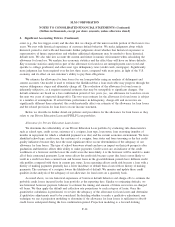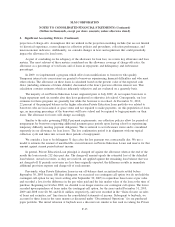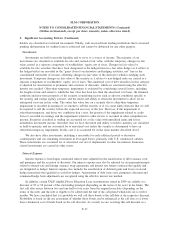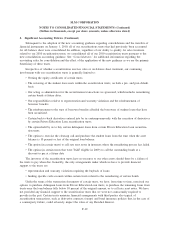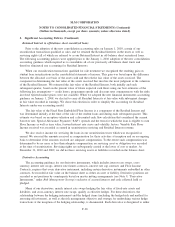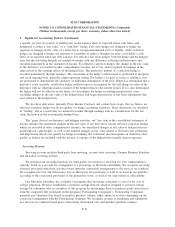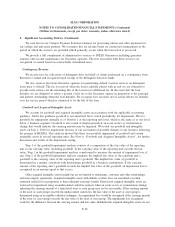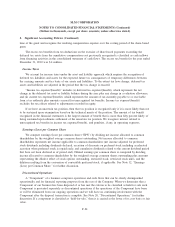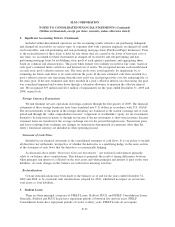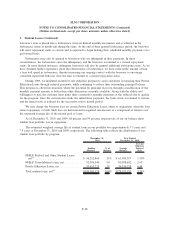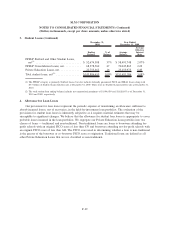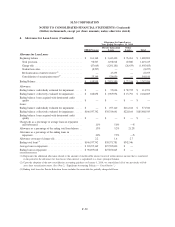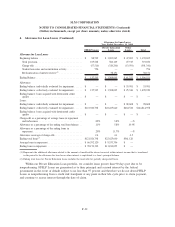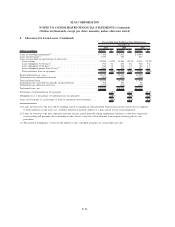Sallie Mae 2010 Annual Report Download - page 127
Download and view the complete annual report
Please find page 127 of the 2010 Sallie Mae annual report below. You can navigate through the pages in the report by either clicking on the pages listed below, or by using the keyword search tool below to find specific information within the annual report.2. Significant Accounting Policies (Continued)
time of the grant and recognize the resulting compensation expense over the vesting period of the share-based
grant.
The excess tax benefits from tax deductions on the exercise of share-based payments exceeding the
deferred tax assets from the cumulative compensation cost previously recognized is classified as cash inflows
from financing activities in the consolidated statement of cash flows. The excess tax benefit for the year ended
December 31, 2010 was $.4 million.
Income Taxes
We account for income taxes under the asset and liability approach which requires the recognition of
deferred tax liabilities and assets for the expected future tax consequences of temporary differences between
the carrying amounts and tax basis of our assets and liabilities. To the extent tax laws change, deferred tax
assets and liabilities are adjusted in the period that the tax change is enacted.
“Income tax expense/(benefit)” includes (i) deferred tax expense/(benefit), which represents the net
change in the deferred tax asset or liability balance during the year plus any change in a valuation allowance,
and (ii) current tax expense/(benefit), which represents the amount of tax currently payable to or receivable
from a tax authority plus amounts accrued for unrecognized tax benefits. Income tax expense/(benefit)
excludes the tax effects related to adjustments recorded in equity.
If we have an uncertain tax position, then that tax position is recognized only if it is more likely than not
to be sustained upon examination based on the technical merits of the position. The amount of tax benefit
recognized in the financial statements is the largest amount of benefit that is more than fifty percent likely of
being sustained upon ultimate settlement of the uncertain tax position. We recognize interest related to
unrecognized tax benefits in income tax expense/(benefit), and penalties, if any, in operating expenses.
Earnings (Loss) per Common Share
We compute earnings (loss) per common share (“EPS”) by dividing net income allocated to common
shareholders by the weighted average common shares outstanding. Net income allocated to common
shareholders represents net income applicable to common shareholders (net income adjusted for preferred
stock dividends including dividends declared, accretion of discounts on preferred stock including accelerated
accretion when preferred stock is repaid early, and cumulative dividends related to the current dividend period
that have not been declared as of period end). Diluted earnings per common share is computed by dividing
income allocated to common shareholders by the weighted average common shares outstanding plus amounts
representing the dilutive effect of stock options outstanding, restricted stock, restricted stock units, and the
dilution resulting from the conversion of convertible preferred stock, if applicable. See Note 12, “Earnings
(Loss) per Common Share,” for further discussion.
Discontinued Operations
A “Component” of a business comprises operations and cash flows that can be clearly distinguished
operationally and for financial reporting purposes from the rest of the Company. When we determine that a
Component of our business has been disposed of or has met the criteria to be classified as held for sale such
Component is presented separately as discontinued operations if the operations of the Component have been
or will be eliminated from our ongoing operations and we will have no continuing involvement with the
Component after the disposal transaction is complete. See Note 20, “Discontinued Operations,” for further
discussion. If a component is classified as “held-for-sale,” then it is carried at the lower of its cost basis or fair
value.
F-24
SLM CORPORATION
NOTES TO CONSOLIDATED FINANCIAL STATEMENTS (Continued)
(Dollars in thousands, except per share amounts, unless otherwise stated)


